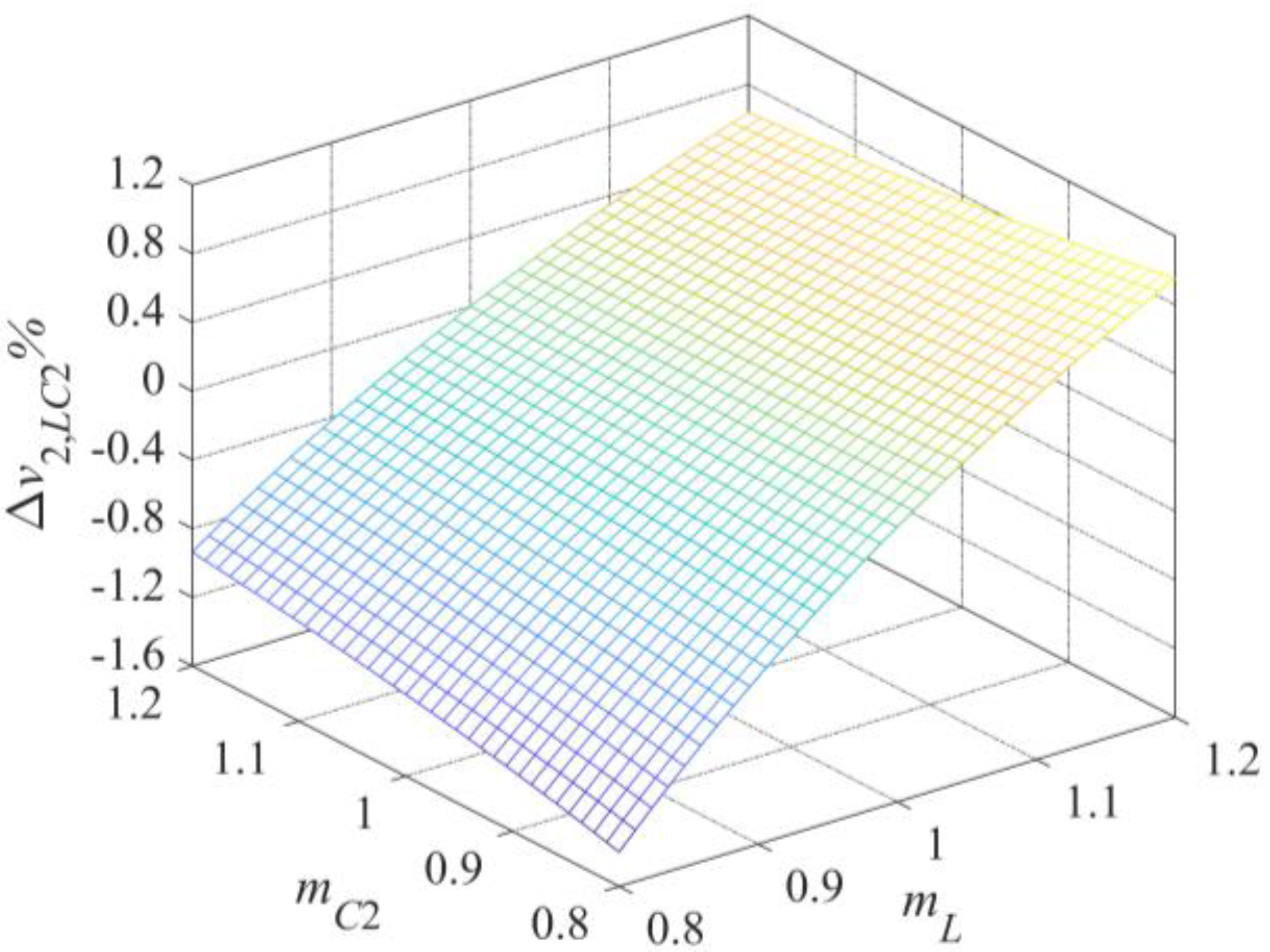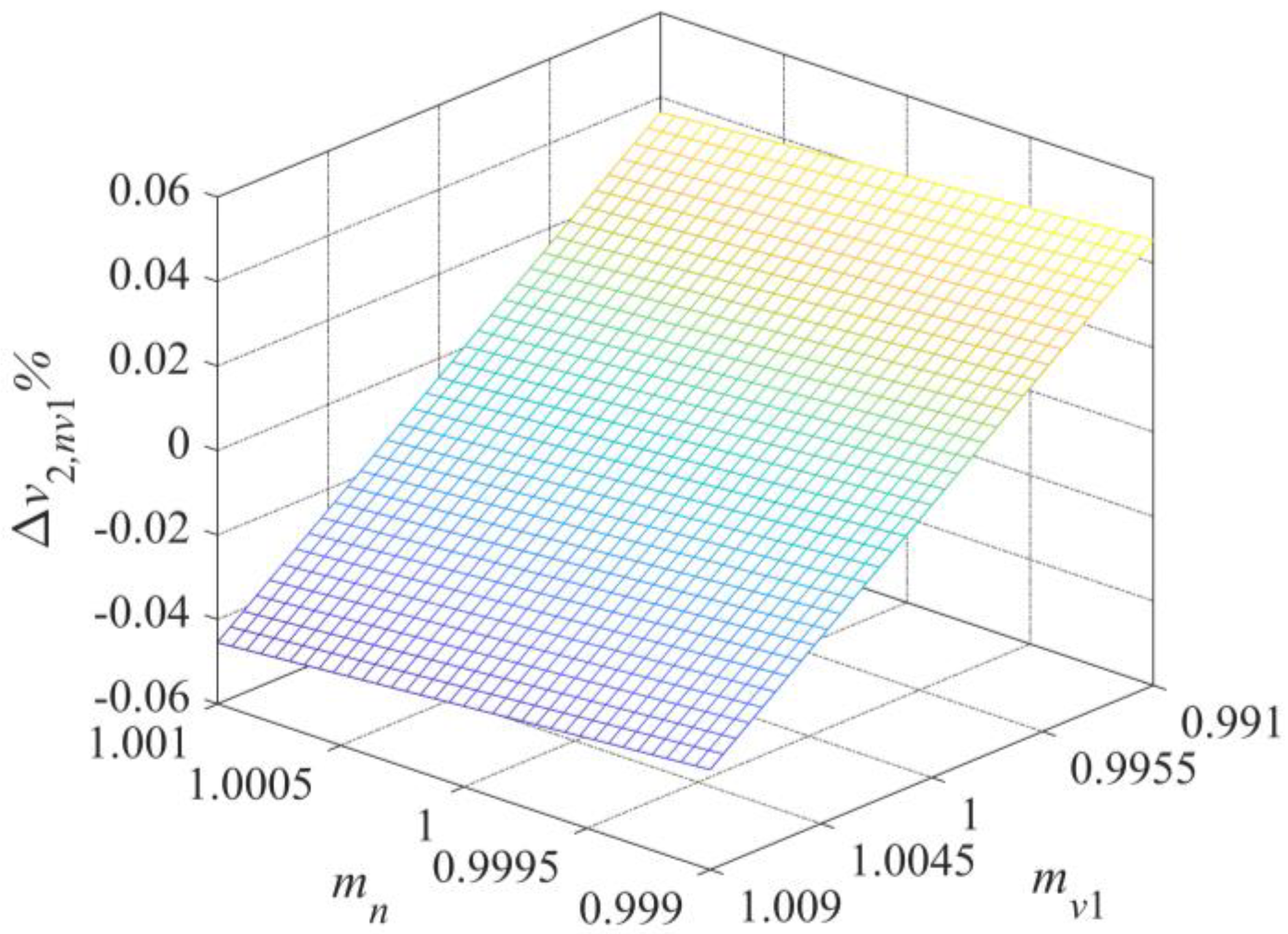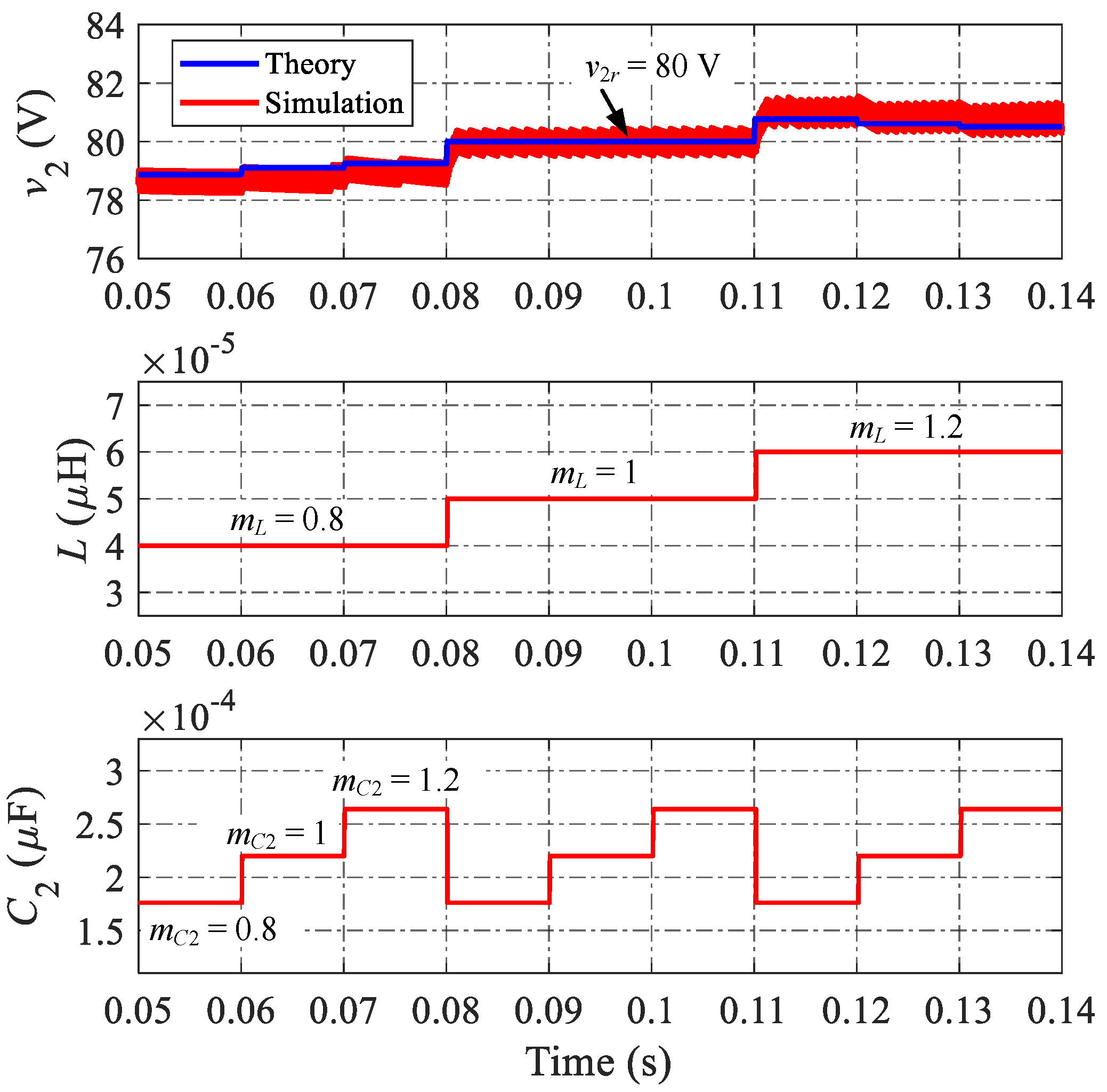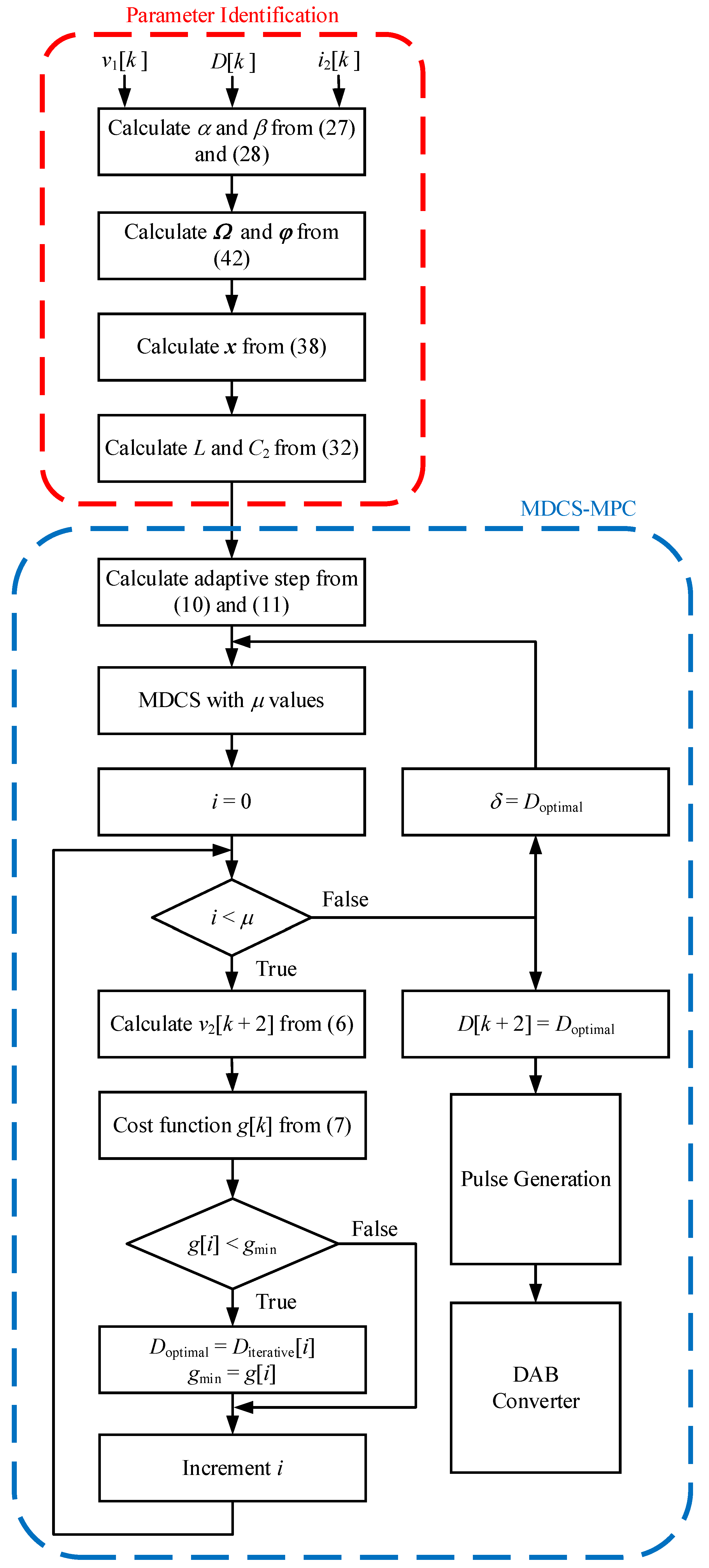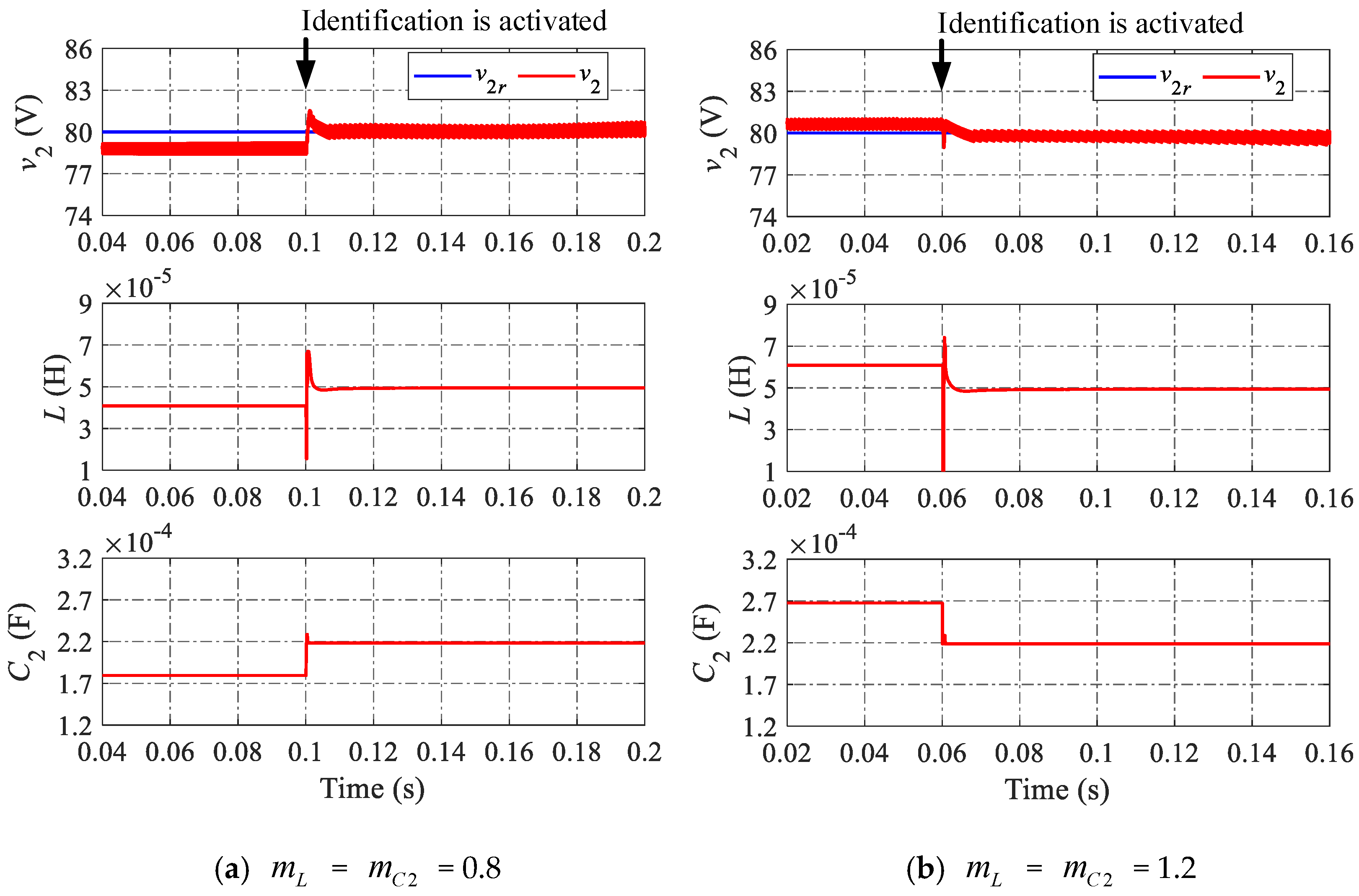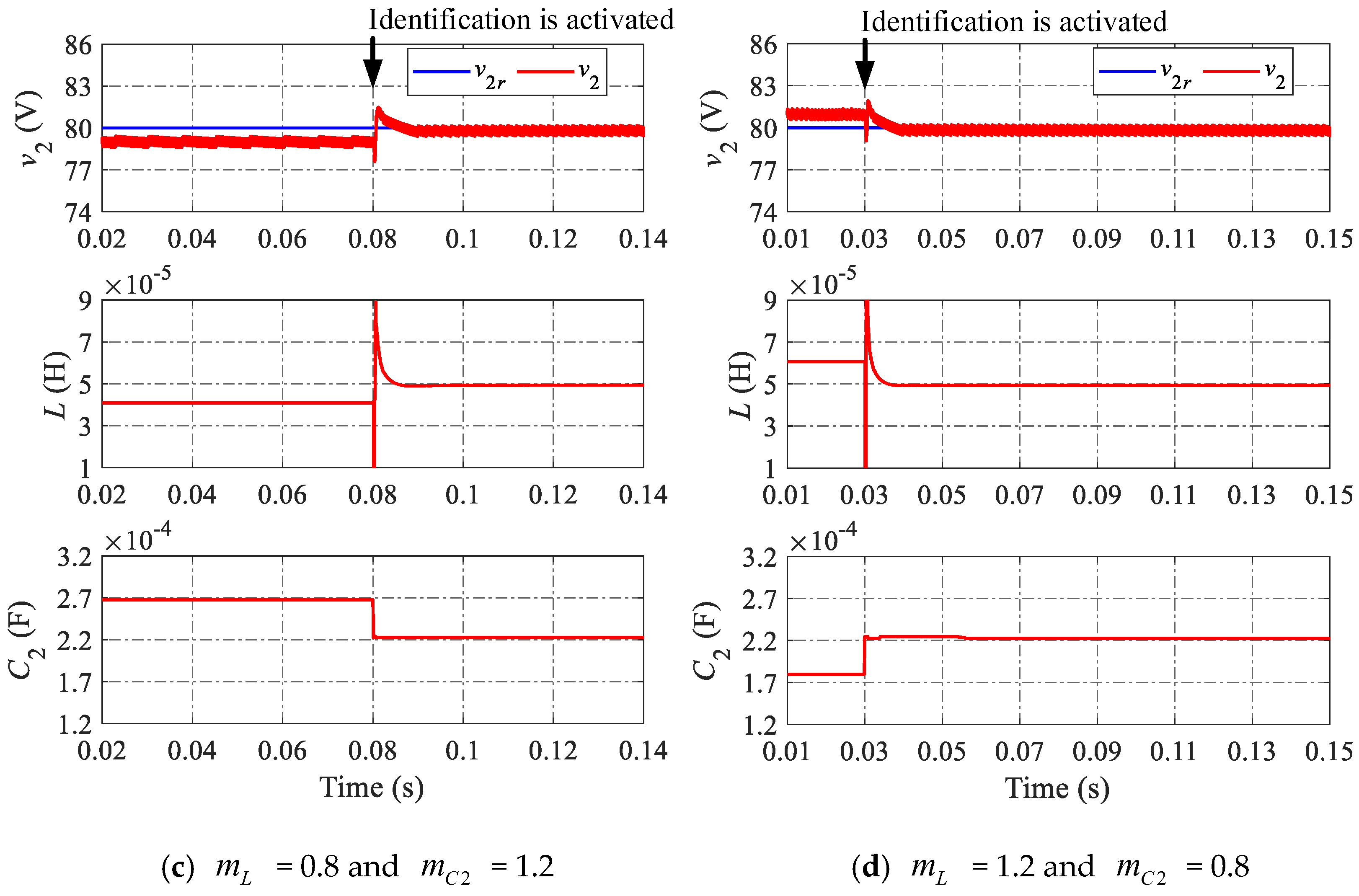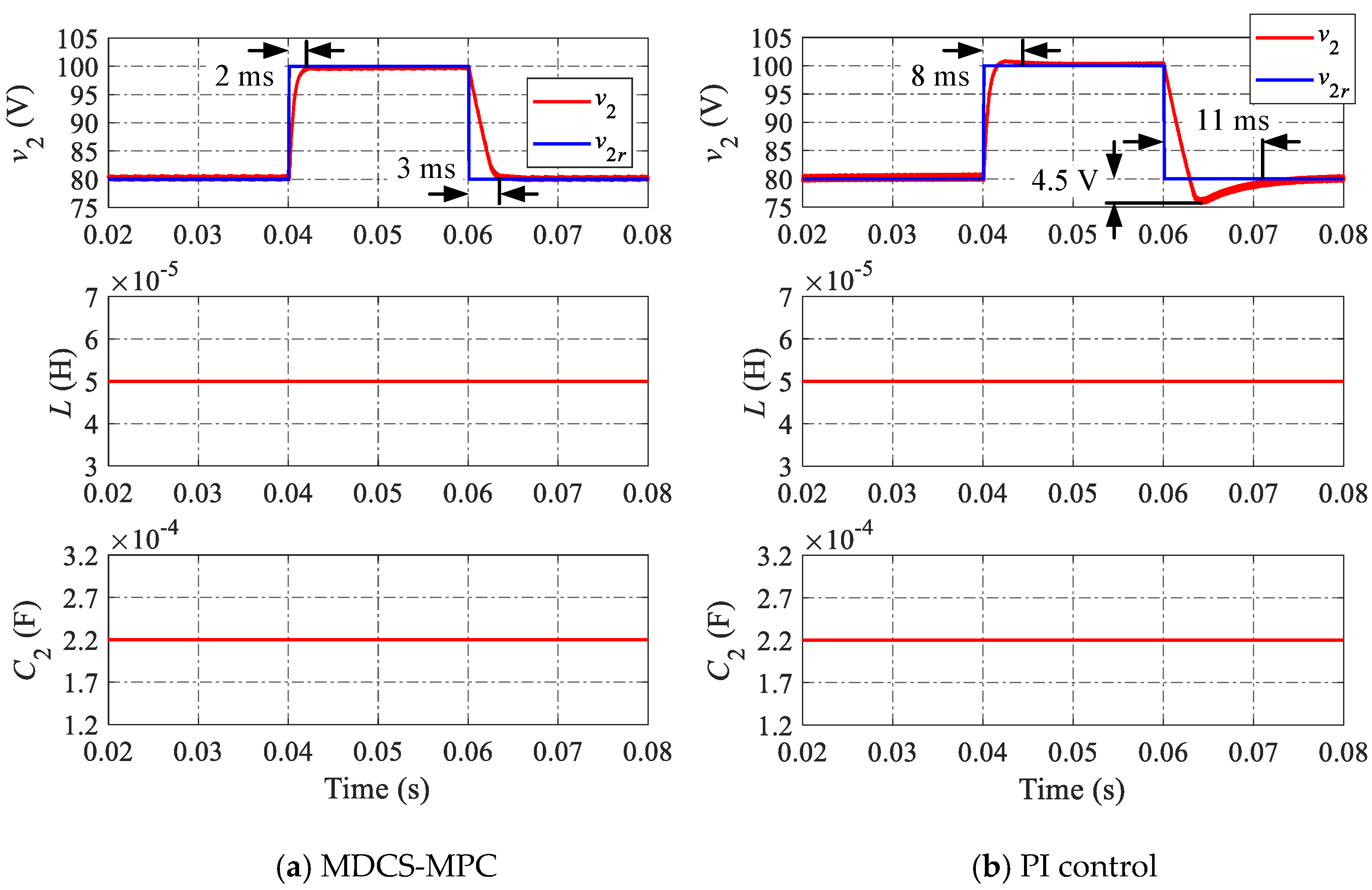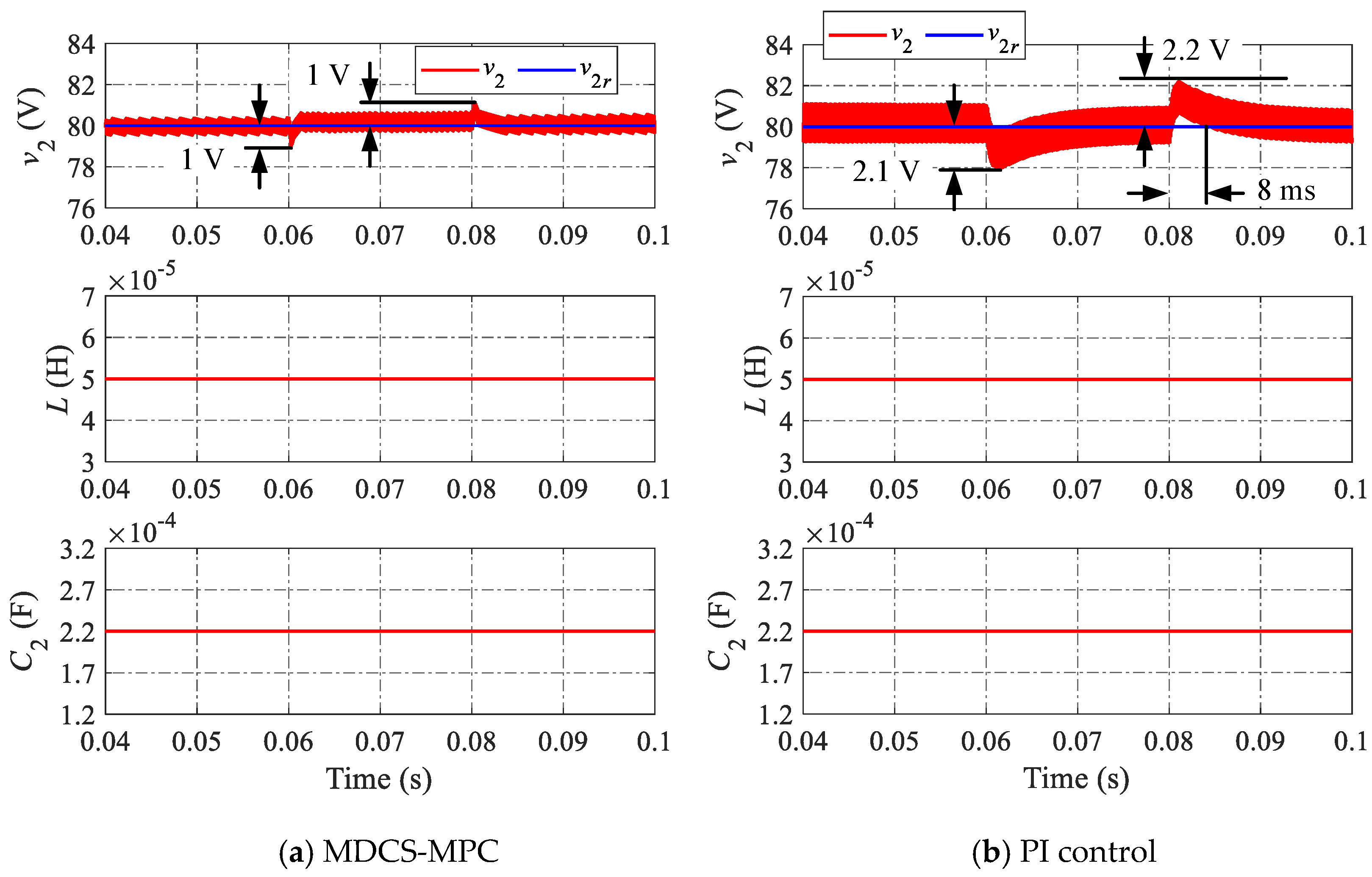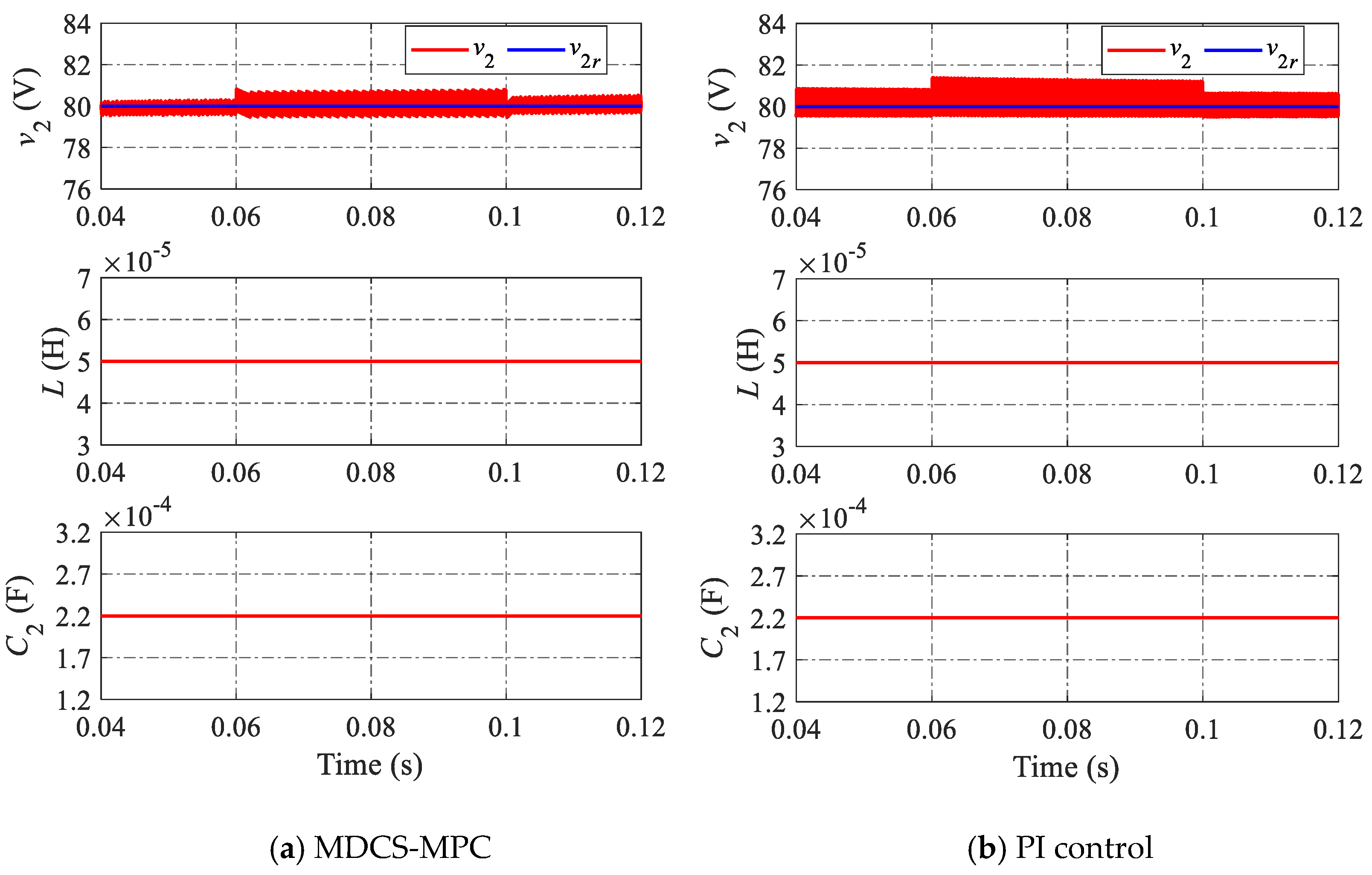1. Introduction
As the demand for electrical applications continues to rise, the DC microgrid has experienced a rapid expansion in recent years. Along with this, the bidirectional DC–DC converters are the fundamental units of the DC microgrid. Using these converters to interlink various renewable energy sources with the DC bus and between the various voltage levels available in DC microgrids is common practice. In energy distribution, many renewable energy sources are connected to energy storage systems (ESSs) and solid-state transformers (SSTs). Because of this, the fundamental functions of DC–DC converters are regulating voltage and current and transferring power in both directions. Despite this, these tasks provide several issues that need more academic and industrial attention [
1,
2,
3,
4,
5,
6].
According to [
2], several different topologies for bidirectional DC–DC converters have been investigated and proposed. Among them, the dual active bridge (DAB) converter, as shown in
Figure 1, is considered one of the potential typologies for the applications of SSTs and ESSs [
7]. These statements are for the following reasons: (1) The DAB converter is built with modular capabilities, symmetric structures, and adjustable phase shift modulations, enabling it to change the power flow direction automatically. As a result, the DAB converter is appropriate for applications that include SSTs and ESSs connecting with DC microgrid. (2) It is essential to have a high voltage and current conversion gain to interface ESSs like batteries and supercapacitors, which might undergo significant changes depending on the state of charge (SOC). In addition, a high voltage and current conversion gain converter is required to complete the connection between the pulsed power loads and the power sources. (3) It is possible to attain a wide zero-voltage switching (ZVS) range by utilizing a variety of phase-shift modulations and advanced control and optimization approaches, ultimately resulting in excellent power efficiency [
2,
6].
For modulation approaches used for transferring the power of the DAB converter, the phase-shift modulation approaches can be categorized as single phase-shift (SPS), extended phase-shift (EPS), dual phase-shift (DPS), and triple phase-shift (TPS).
Table 1 shows the comparison of modulation. These designations are based on the number and kinds of phase-shift ratios that the modulation approaches use. Compared with EPS, DPS, and TPS, the SPS is the modulation utilized most frequently due to its simplicity by using only one phase-shift ratio as the control variable [
1,
2,
3,
4,
5,
6]. Therefore, this paper utilizes the SPS to show the proposed method’s effectiveness.
Numerous advanced control methods are proposed for the DAB converter, according to [
3], such as linearization control [
8], output current feedforward control [
9], virtual direct power control [
10], disturbance observer-based control [
11,
12,
13], feedforward current control [
14], predictive current control [
15,
16], and sliding mode control [
17,
18,
19]. These control strategies have the potential to stabilize and increase the steady-state performance of the output voltage while simultaneously ensuring high dynamics. Compared to other advanced methods, moving discretized control set model predictive control (MDCS-MPC) is frequently considered in power electronics converters due to its numerous benefits, including fast dynamics, easy inclusion of constraints in the cost function, and multiobjective control [
20,
21,
22,
23,
24].
Table 2 shows the comparison of the control method, according to [
1,
2,
3,
4,
5,
6].
Even though all of the advanced control methods have excellent dynamic performance, they are highly dependent on the accuracy of the system model, which results in a degradation in the steady-state performance if there is a mismatch of the system parameters. This limitation is because the controller’s information usually differs from the hardware’s. In experiments, the values of system parameters such as inductor and capacitor might somewhat shift over time [
25,
26] due to temperature drift, manufacturing tolerance, age, and operating circumstances; as a result, parameter mismatches of up to 20% can sometimes be observed [
27,
28]. Therefore, if the system parameters are identified online accurately while the operation is carried out, the steady-state performance significantly improves.
In order to overcome the effect of parameter mismatch, MPC with complex multiobjective optimization control is used in [
29] to control the power converter or produce a feed-forward compensator in [
30] for a programmable logic controller system. However, they are complicated. On the other hand, to identify parameters online, a model-based feed-forward control strategy combined with recursive least-squares (RLS) is proposed in [
31], and a model predictive control with a novel parameter identification scheme of RLS in [
32]. However, they do not consider other parameters, such as capacitors. Another method for calculating the parameters presented in [
33] can use gradient calculation of the least-squares error function. This technique can identify the actual values using the MPC combined with the least-squares estimate method. However, the least-squares solution presented in [
33] with the matrix belonging to
results in a complicated calculation. In addition, it involves previously and currently measured data, resulting in degraded dynamic performance, as mentioned in [
31]. On the other hand, identifying the parameters of the transformer may also be accomplished through the instantaneous phasor method [
34] and RLS-based parasitic parameter extraction [
35]. However, these control strategies cannot determine capacitor value on both sides of the DAB converter, and their algorithm is also complicated.
Based on those mentioned above, this paper proposes a method for enhancing the steady-state performance of the DAB converter with MDCS-MPC control. At the same time, the system parameters are identified online to eliminate the effects of mismatch. Firstly, sensitivity analyses are carried out for system parameters and the other measured parameters to determine how each parameter impacts the steady-state performance of the converter. After that, the online parameter identification technique is carried out to track the most vital parameters using least-squares analysis (LSA), which is considered the most straightforward technique to find the optimal solution of the linear equation set, according to [
36]. The contributions of this research can be summarized as follows:
The percentages of steady-state error for major system parameters and measurement parameters of the DAB converter are first modeled mathematically. Based on this, a comparison of the percentages of steady-state error is implemented, showing that system parameters and have the most effect on the output voltage compared to the other parameters. In addition, the effects of system parameters and are compared in depth through sensitivity analysis by the partial derivative-based method. Then, through simulation verification, the MDCS-MPC shows that it is adversely affected by a mismatch in the system parameters. Simulation results show that the mathematical model is consistent with those in theory, demonstrating the correction of the mathematical model and those in sensitivity analysis.
A simple parameter identification technique with the LSA is proposed to identify the DAB converter’s actual values of system parameters. After that, by applying their actual values in the MDCS-MPC, the steady-state performance of the output voltage is significantly improved. Moreover, the MDCS-MPC under the match parameters is compared to the proportional–integral (PI) control to show its effectiveness.
The outline of the paper consists of seven sections. In
Section 2, the operation principle of the DAB converter under SPS modulation is shown. In
Section 3, a brief review of the operating principle of the MDCS-MPC method is presented for perusal.
Section 4 discusses and analyzes the analysis of the parameter effects on the steady-state performance and sensitivity analysis of the system parameters of the DAB converter.
Section 5 presents the parameter identification technique of the LSA. Simulation results of the DAB converter under different operating scenarios are carried out to show the proposed method’s benefit in
Section 6. Finally, the conclusions of the method are presented in
Section 7.
2. Operation Principle of the DAB Converter
Figure 1a shows the topology of the DAB converter. Assume that the high-frequency transformer
T has a turns ratio of
n:1, and the power is transferred from the left to the right. The input and output sides are connected to capacitors
and
, respectively. The inductance, denoted by
, includes the transformer’s leakage inductance and series inductance.
Figure 1b shows the waveforms produced by the DAB converter when subjected to SPS modulation. Therefore, the power transmission between the two bridges is accomplished with a phase-shift ratio of
. The switching frequency is denoted by
while
Th represents the half-switching period.
Several comprehensive modeling research studies on DAB converters can be found in [
37,
38,
39]. Considering that, the DAB converter is regarded as a first-order system. Compared to other models, such as the enhanced reduced-order model [
40], the generalized average model [
41], and the discrete-time model [
42], the reduced-order model [
37,
43] has been demonstrated to be an excellent middle ground among complexity, flexibility, and accuracy. Reference [
3] contains additional information regarding comparing various DAB models. Because of this, the reduced-order model will be applied repeatedly throughout this study. Thus, the current
can be represented as follows when the converter is in the steady state
According to (1), it is easy to see that the transferred power will be through the converter when
. The transferred power has a maximum value when
. Thus, from
Figure 1, the output current can be obtained as follows
On the other hand, to implement the system model dynamically into the digital signal processor (DSP) easily, the approximation of the first-order derivative can be utilized. Compared to central approximation, backward and forward approximations are straightforward to implement. Thus, the forward approximation is used to discretize (2) as follows [
21]
where
and
are the output voltages at the (
k + 1)th and
kth sampling step, respectively.
and
are the bridge output current and converter output current at the
kth sampling step, respectively.
Assuming that there is not a significant change in the load current during one sampling period, this results in
Thus, the prediction of the output voltage at the (
k + 1)th sampling step is as follows
Substituting
into (3)–(5), (6) is obtained as follows
3. Review of Moving Discretized Control Set Model Predictive Control (MDCS-MPC)
In this section, the operating principle of MDCS-MPC will be briefly summarized from [
20,
21,
22,
23,
24]. Considering the delay computation, MDCS-MPC has a prediction horizon that spans two sampling intervals. As a result, the following cost function is proposed as follows
In (7), the weighting factor
adjusts the output voltage error from the reference value
, while the weighting factor
determines the voltage fluctuation. Obviously, tuning
and
is intuitively crucial to the performance of the MDCS-MPC. In addition, a relative weighting factor
can be chosen as follows
In (8), if is chosen too small, the system cannot always converge. However, if is chosen too large, the control bandwidth of the controller will be reduced. Actually, selecting weighting factors requires a sequence of trial and error.
For digital control, the phase-shift ratio
must be discretized. The precision of the discretization depends on the control platform being utilized, with the value
being the finest phase-shift value. As shown in (9), the phase-shift ratio is discretized for simple analysis when the power is transferred in a unidirectional mode
Figure 2 shows an intuitive mechanism of the MDCS-MPC method. For example, during the control interval from
k to
k + 1, the number of points
μ = 3 is examined. The discretized control set is
. After every period of sampling, the center point is recalculated. According to
Figure 2, the optimal value of
, as shown in the red line, is changed from
to
when the sampling step evolves from
k to
k + 1. Thus, the discretized control set continuously progresses within the value range, as shown in (9). Obviously, increasing
μ can improve the transition dynamics. However, it also places a significant computational burden on the controller. Thus, an adaptive step is utilized as follows
where
is the saturated voltage;
is a coefficient determined according to the requirement of transition performance.
A concise summary of the MDCS-MPC operation principle for the DAB converter can be found as follows. Firstly, the evaluation process begins with calculating the adaptive step, as shown in (10) and (11). Once this is completed, the iteration for MDCS-MPC begins with shifts within the range described in (9). Then, to compare the minimal, cost functions, as shown in (7), are computed with each corrected voltage prediction value, as shown in (6). Finally, the optimal values of are then used to control the DAB converter through a pulse width modulation generator.
4. Analysis of the Parameter Effects on the Steady-State Performance
As presented in
Section 2, six model parameters of the DAB converter, including system parameters (
,
, and
) and measurement parameters (
,
, and
), affect the steady-state performance.
First, the mismatch ratios of the inductance (
) and output capacitance (
) are defined as shown in (12)
where
and
are the actual values of
and
, respectively.
In the steady state, the average current flowing through the output capacitor is deemed equal to zero. Thus, it is possible to assume that the current
[
44]. Consequently, from (1), (12), and the fact that
is controlled as
, the output voltage according to
and
is rewritten as follows
From (13), the percentage of steady-state error
is derived as follows
Figure 3 shows the percentage of steady-state error
according to
and
. Mismatch ratios
and
are shown in
Table 3, considering the maximum mismatches as analyzed in
Section 1. The parameters of the converter are shown in
Table 4. According to
Figure 3,
has a maximum value of 0.9560% when
= 1.2 and
= 0.8. On the other hand,
shows the minimum value of −1.4006% when
=
= 0.8. Meanwhile, when
= 1,
has a value of 0, which means that if
has a perfect match value,
has no steady-state error, even if
contains mismatches.
Similar to the above analysis, the mismatch ratios of the transformer turn ratio
and input voltage
are defined as
where
and
are the actual values of
n and
, respectively.
Thus, the output voltage in the steady state is shown as follows
From (16), the percentage of steady-state error
according to
and
is derived as follows
Figure 4 shows the percentage of steady-state error
according to
and
. The range of mismatch ratios is shown in
Table 3. According to LEM manufacture (current transducer LA 55-P and voltage transducer LV 25-P), the sensor accuracy is typically less than 0.9%. For the accuracy of
, it is easily measured by electronic equipment. Thus, it is clear that the mismatch of 0.1% is acceptable. From
Figure 4, it is easy to see that
has a maximum value of 0.0454% and a minimum value of −0.0455%. Obviously, these values are close to zero.
Similarly, the mismatch ratios of the output current
and output voltage
are defined as
where
and
are the actual values of
and
, respectively.
Thus, the output voltage in the steady state is as follows
From (19), the percentage of steady-state error
according to
and
is derived as follows
Figure 5 shows the percentage of steady-state error
according to
and
. The range of mismatch ratios is shown in
Table 3.
has a maximum value of 0.0808% and a minimum value of −0.0829%. Similar to
, these values are close to zero.
Table 5 and
Figure 6 compare all the percentages of steady-state error. It is clear that
has the highest absolute value, while both
and
have very small values. That means system parameters
and
have the most effect on the output voltage compared to the other parameters. Thus, the effects of the transformer turn ratio
and the sensor accuracies (
,
, and
) can be considered trivial. Moreover, this effect can be overcome if a robust and adaptable controller is utilized. Fortunately, MDCS-MPC combined with the parameter identification technique is regarded as one of the advanced control methods with a high capacity of robustness and adaptiveness [
1,
2,
3,
4,
5,
6]. The effectiveness of the proposed controller will be presented in detail in
Section 5.
From the analysis mentioned above, it is concluded that system parameters
and
primarily affect the output voltage compared to the others. To analyze the effect of system parameters
and
, the sensitivity theory is studied on how the uncertainty of the system model affects the steady-state performance [
45,
46]. Many approaches to performing a sensitivity analysis of multiple parameters have been developed, including derivative-based methods [
47], one-at-a-time sampling [
48], and regression analysis [
49]. In this paper, the partial derivative-based method [
47] involves taking the partial derivative of the output
with respect to an input factor
, which is utilized to achieve the task. Thus, the sensitivity can be derived by the following general equation
Therefore, the sensitivities
and
of
and
to the output voltage
, respectively, are derived according to (13) and (21) as follows
From (22) and (23), the values of
and
are shown in
Figure 7 with parameters in
Table 4. Obviously,
is a greater distance from 0 than
, and as a result, the sensitivity of
has a more significant impact on the system compared to
.
has minimum and maximum values at −0.0097 and 0.0138, respectively, while
has minimum and maximum values at 0.0320 and 0.0690, respectively. Moreover, according to
Figure 3, it is easy to see that when
has a mismatch,
also affects
. Therefore,
and
must be identified online together to improve the steady-state performance of the DAB converter.
Figure 8 shows simulation results of MDCS-MPC with various mismatches of
and
. System parameters are shown in
Table 4, and the control variables of MDCS-MPC are shown in
Table 6. Note that the number of points
μ is chosen to balance performance and complexity. The output voltage is controlled at 80 V. Obviously, there is no steady-state error from 0.08 s to 0.11 s when
and
have actual values (
= 50 μH and
= 220 μF, meaning
=
= 1). When
=
= 0.8, the steady-state error has a minimum value, while it has a maximum value when
= 1.2 and
= 0.8. In other instances of mismatch, there are also the steady-state errors. On the other hand, the simulation result is primarily consistent with the theoretical analysis, proving the effectiveness of theoretical analysis and the effect of
and
on MDCS-MPC in steady-state operation.
5. Parameter Identification Technique
As in the detailed analysis in
Section 4, there are steady-state errors of
in MDCS-MPC when the system parameters
and
have mismatch values. Thus, their parameters are identified online using a simple parameter identification technique, as presented below.
From (1)–(6), the constraint of the output voltage between sampling steps is derived as follows
By rearranging (24), we obtain
From (25), the following is obtained
where
By rearranging (25) to the matrix form, the following is obtained
where
,
, and
, presented as follows
In (31)–(33), constant is the forgetting factor. Considering that the abrupt alteration in operating scenarios (for instance, reference voltage steps up, etc.) and the system parameters (for instance, one of the parallel capacitors is damaged, etc.) renders the previously measured data less critical, and the impacts of such data must rapidly disappear. When is somewhat near , the previously measured data should be required less frequently as the sampling step increases. In most cases, the range 0 < ε < 1 is selected for the variable to provide versatility. If is too small (close to zero), the estimator’s performance will suffer since it will be more susceptible to being affected by noise or disturbance. On the contrary, when approaches 1, there is a slight forgetting effect. This means that the solution of the proposed approach is mainly driven by the previously obtained data, which slows down the convergence speed. In regular hardware operation, and are usually subject to slow variation, resulting in needing to be set as close as possible to 1. In this paper, = 0.99 is used.
From (30)–(33), the following expression is obtained
By using the LSA according to [
36], a mean square error is derived as follows
In order to obtain a unique minimizer, a derivation is as follows
As a result,
is obtained as follows
The online identification of
is accomplished by substituting (31)–(33) into (37). On the other hand, the matrix and vector both have a growing number of rows, which significantly burdens the controller and makes the solution impracticable. Therefore, (38) should be rewritten to reduce the dimensionality of all the matrices and vectors
where
Therefore, the elements from (39) and (40) can be calculated as follows
From the point of view of (41), there is a successive recurrence relation of the elements in order to ensure the easy implementation of the proposed approach, as shown in (42)
Different from the matrix and vector having many elements, and . Thus, a simple calculation of the inverse matrix significantly mitigates the calculation burden.
The flowchart of the proposed method is shown in
Figure 9. First,
and
are derived from (27) and (28), respectively. Then,
and
are calculated from (42), while
x is calculated from (38). After the system parameters
and
are identified online from (32), the adaptive step of MDCS-MPC is calculated based on (10) and (11). MDCS-MPC will generate a range of phase-shift ratios with the number of points
μ. Then, the iteration starts for MDCS-MPC by comparing values of the cost function of corresponding phase-shift ratios to find the optimal values of
.
6. Simulation Verification
In this section, the effectiveness of the proposed method is verified through simulation. In addition, the dynamic performance of MDCS-MPC is compared with PI control under match system parameters. Gains of PI control are designed according to [
50].
Figure 10 shows the steady-state error of
in MDCS-MPC before and after parameter identification. Initially, MDCS-MPC operates under mismatch parameters, as shown in
Figure 10a, showing the steady-state error from 0.04 s to 0.1 s. However, when the parameter identification technique is applied at 0.1 s, the steady-state error immediately disappears, meaning the steady-state performance is immediately improved. Moreover, the values of
and
are also identified online as the actual values. Obviously, when MDCS-MPC is combined with the parameter identification technique, the steady-state performance of the proposed controller is significantly improved. Similar to
Figure 10a, other cases of mismatch system parameters are shown in
Figure 10b–d. When the parameter identification technique is applied, the steady-state error immediately disappears. It is easy to conclude that both steady-state and identification performances also prove the effectiveness of the proposed method.
As shown in
Figure 11, MDCS-MPC is compared with the PI control under the match system parameters. When
steps up at 0.04 s, the MDCS-MPC costs 2 ms for settling time with overshoot-free, while the PI control costs 8 ms with a slight overshoot value. On the other hand, when
steps down at 0.06 s, the MDCS-MPC costs 3 ms for settling time with undershoot-free, while the PI control costs 11 ms with an undershoot of 4.5 V. Obviously, compared to the PI control, the MDCS-MPC provides better dynamic performance for the reference voltage change step.
Figure 12 compares the dynamic performance of the output voltage of the two methods under the match system parameters. When
steps up at 0.06 s, the MDCS-MPC shows 1 V for undershoot, while the PI control shows 2.1 V. On the other hand, when
steps down at 0.08 s, the MDCS-MPC shows 1 V for overshoot, while the PI control shows 2.2 V for overshoot with 8 ms for settling time. Obviously, compared to the PI control, the MDCS-MPC also provides better dynamic performance when changing the output current.
Figure 13 shows the simulation results when the input voltage
steps up from 95 V to 100 V at 0.06 s and steps down from 100 V to 95 V at 0.1 s under the match system parameters. When
changes, both MDCS-MPC and PI control have good dynamic performance, but there are more voltage ripples in the PI control compared to the MDCS-MPC.


